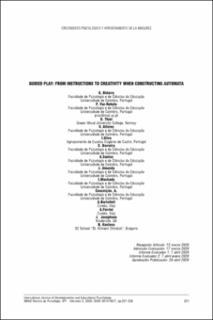| dc.contributor.author | Bidarra, Graça | |
| dc.contributor.author | Vaz-Rebelo, Piedade | |
| dc.contributor.author | Thiel, Oliver | |
| dc.contributor.author | Alferes, Valentim | |
| dc.contributor.author | Silva, Isabel | |
| dc.contributor.author | Barreira, Carlos | |
| dc.contributor.author | Santos, A. | |
| dc.contributor.author | Almeida, Jorge | |
| dc.contributor.author | Machado, I | |
| dc.contributor.author | Conceição, A. | |
| dc.contributor.author | Bartolleti, Corinna | |
| dc.contributor.author | Ferrini, Francesca | |
| dc.contributor.author | Josephson, Joel | |
| dc.contributor.author | Kostova, Nelly | |
| dc.date.accessioned | 2021-11-12T13:36:52Z | |
| dc.date.available | 2021-11-12T13:36:52Z | |
| dc.date.created | 2020-05-15T18:15:30Z | |
| dc.date.issued | 2020 | |
| dc.identifier.citation | International Journal of Developmental and Educational Psychology. 2020, 2 (1), 221-228. | en_US |
| dc.identifier.issn | 0214-9877 | |
| dc.identifier.uri | https://hdl.handle.net/11250/2829378 | |
| dc.description.abstract | Play is a very important activity for children development and there are evidences that it can be an added value when used for educational purposes. Research about how to integrate play in education points to the importance of teacher role, namely how children play can be scaffold and guided. However, there is also lack of agreement about how to guide children playing and the impact of the guidance in the activity development and competences promoted. Given the characteristics of automata, especially the fact that they include a narrative and a mechanism, they can be used within a play based pedagogy, to implement activities related to plan and construct toys and to promote competences as observation, problem solving, creativity in the STEM areas. To explore this potential of moving toys to promote STEM in the early years of schooling is the aim of the Erasmus + AutoSTEM project. This work aims to describe the main objectives and resources of the AutoSTEM project, including the description of a workshop to construct a toy with a sliding mechanism, the Jelly Bird. The procedures involved the presentation and observation of the toy, detailed instructions on how to construct it, the decoration and the elaboration of a narrative about it. 23 children from the 2nd year of basic education participated in the workshop. The analysis of the prototypes shows that all the participants built them properly. Also some alternative ideas to the proposal initially presented emerged, as well as a diversity of narratives. These data suggest that the instructions enhanced the construction of the prototype, but did not inhibit the creativity of the work developed. | en_US |
| dc.language.iso | eng | en_US |
| dc.rights | Attribution-NonCommercial-NoDerivatives 4.0 Internasjonal | * |
| dc.rights | Attribution-NonCommercial-NoDerivatives 4.0 Internasjonal | * |
| dc.rights.uri | http://creativecommons.org/licenses/by-nc-nd/4.0/deed.no | * |
| dc.subject | Automata | en_US |
| dc.subject | guided play | en_US |
| dc.subject | creativity | en_US |
| dc.subject | learning | en_US |
| dc.title | Guided play: From instruction to creativity when constructing automata | en_US |
| dc.type | Journal article | en_US |
| dc.description.version | publishedVersion | en_US |
| dc.source.pagenumber | 8. | en_US |
| dc.source.volume | 2 | en_US |
| dc.source.journal | International Journal of Developmental and Educational Psychology | en_US |
| dc.source.issue | 1 | en_US |
| dc.identifier.cristin | 1811299 | |
| dc.relation.project | EU/2018-1-PT01-KA201-047499 | en_US |
| cristin.ispublished | true | |
| cristin.fulltext | original | |

